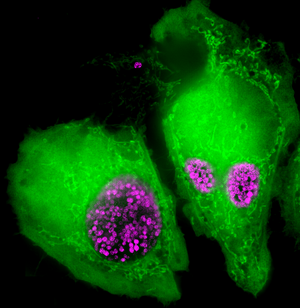Chlamydiales
Chlamydia are the most common cause of sexually transmitted diseases (131 million per year), bacterial eye infections and community acquired pneumonia. Additionally, these bacteria are associated with chronic diseases like carcinomas of the cervix and ovaries and atherosclerosis. All members of the Chlamydiales are obligate intracellular bacteria which replicate in host cells within the boundary of a vacuole called inclusion. We investigate the mechanisms of intracellular adaptation, the bacteria-induced subversion of the cell autonomous and innate immune defence and the connection of Chlamydia infection to ovarian and cervix carcinoma.

The innate immune defense against Chlamydia
Read on here
The cell autonomous immune defense against Chlamydia
Read on here
Chlamydia infection - a risk factor for ovarian and cervix carcinoma?
Read on here
The role of sphingolipids in Chlamydia infection
Read on here
The role of organellar sphingolipids in Simkania negevensis infection
Read on here.
Ubiquitin-modifying enzymes and their role in Simkania negevensis infection
Read on here.
Metabolic interactions of Chlamydia and the host cell
Read on here.
The Chlamydia intracellular niche
Chlamydia live inside human cells and entirely depend on host metabolites for their survival and proliferation. The same time, infection creates enormous stress to the host cell which cumulates in e.g. severe damage of the host’s DNA. In this research project we aim to understand how the bacteria generate their intracellular niche in the host cell, acquire nutrients from the host and subvert host cell metabolic control mechanism.
We currently investigate the role of oncogenic signalling in the metabolic adaptation of Chlamydia. Our recent data demonstrated a central role of the tumour suppressor p53 in the control of Chlamydia infection. p53 is actively downregulated in cells infected with Chlamydia to overcome the suppression of host metabolism and particularly preserve the function of mitochondria, a main source of metabolites for Chlamydia.
Read on here.







